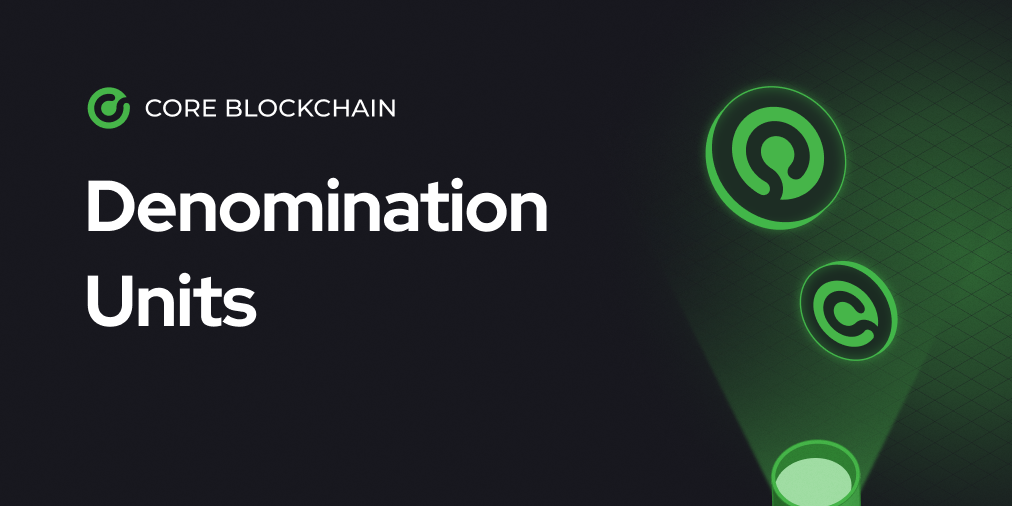A Comprehensive Guide to Core Coin’s Denomination Units

Anyone who ever held money in their hands will know that dollars break into cents, pounds break into pennies, and yens break into sens. However, did you know, that cryptocurrencies break into smaller units, too? And usually, it is several of them.
It is quite understandable that every major cryptocurrency needs its “cents” or subunits, i.e. denomination units. The role of digital assets is not exclusively limited to the store of value anymore. Quite the opposite, crypto is gradually becoming a means of payment among communities.
Now, imagine Bitcoin and the astronomical value it sometimes acquires. If we were to pay with BTC, we could not just pay a tenth of Bitcoin to someone for a service. The biggest cryptocurrency, in fact, contains 8 denomination units, the smallest of which is known as Satoshi and represents 0.00000001 BTC.
As it is with all the cryptocurrencies out there, Core Blockchain’s native Core Coin (XCB) also contains several subunits, which we will describe to you.
What Are Core Coin’s Subunits?
Core Coin (XCB) is a very unique cryptocurrency that can boast of not 1, not 8, but 15 denomination units, representing 18 decimal points below Core and 26 places above it.
The main unit of the Core Blockchain is Core (₡) and represents the value of 1E+18, which means it contains 18 decimal places. Its alias is also known as Core. Its symbol (🟢️️) is a green dot — a color associated with the Core Blockchain, representing a true eco-friendly network.
Coming all the way down, the smallest unit of XCB is called Ore.
The units that follow each represent a further shift in three decimal places. They are, respectively: wav, grav, nucle, atom, moli, core, aer, orb, plano, tera, sola, galx, cluster, and supermatter.
You can find further details, such as aliases, symbols, or values in the following chart:
| Name | Alias | Unit | Symbol | SI | Value |
|---|---|---|---|---|---|
| Ore | Ore | ø | 🔷 | ["atto","a"] | 1E+00 |
| Wav | Fecore | 〰️ | ["femto","f"] | 1E+03 | |
| Grav | Picore | ➰ | ["pico","p"] | 1E+06 | |
| Nucle | Nacore | ꞥ | ✴️ | ["nano","n"] | 1E+09 |
| Atom | μcore | ⚛️ | ["micro","μ"] | 1E+12 | |
| Moli | Micore | ₥ | ❇️ | ["mili","m"] | 1E+15 |
| Core | Core | ₡ | 🟢️️ | 1E+18 | |
| Aer | Kicore | ₳ | 🌀️ | ["kilo","k"] | 1E+21 |
| Orb | Mecore | ☄️ | ["mega","M"] | 1E+24 | |
| Plano | Gicore | Ᵽ | 🪐️ | ["giga","G"] | 1E+27 |
| Tera | Tecore | 🌐️ | ["tera","T"] | 1E+30 | |
| Sola | Precore | 💫️ | ["peta","P"] | 1E+33 | |
| Galx | Excore | Ǥ | ✨️ | ["exa","E"] | 1E+36 |
| Cluster | Zecore | 💠️ | ["zetta","Z"] | 1E+39 | |
| Supermatter | Yocore | ₷ | 🔱 | ["yotta","Y"] | 1E+42 |
Further Economic Description of XCB’s Subunits
For those a little more technical of you who would like to learn more about the denomination units and their roles within the hierarchy of the Core Bockchain, we have a few more specifications.
When it comes to the smallest unit, Ore ø, it can prove convenient with micro transfers and calculations of the fees, called energy.
Wav (wave) as a unit enables easier calculation with the smallest units and can be used in micro payments as well.
Following Wav is Grav (Gravity), which functions as a direct breaking denominator for Nucle ꞥ, which serves as the main fees unit, while Atom (Atom) which belongs a step above serves mostly to batch the fees or represents a smaller value of it.
You can use Moli ₥ for micro transfers or to transfer a fraction of Core ₡, the main unit of the Core Blockchain.
Aer ₳ is the first next step above the Core Coin itself and serves to batch XCB into clusters of higher value, while Orb (Orbit) is better used for mass payments where additional redistribution is needed.
Plano Ᵽ is a unit that serves to collect financial tools represented by Core and Tera is a unit used for collecting the chunks of financial assets in bigger amounts.
Sola represents a unit that serves to manage large financial assets. Above Sola, Galx Ǥ can be used for macroeconomics and its derivations.
The two biggest units of the Core Coin are Cluster and Supermatter. Cluster represents economic money for the Core cryptocurrency, such as M1 and M2. And finally, Supermatter ₷ poses as the whole economic system for Core Blockchain.
Now You Are Ready
We do hope that we have not confused you too much with the various subunits of Core Coin. Quite the opposite, we hope that now you will have enough knowledge of the Core Blockchain and its native currency to confidently enter the market and buy, let’s say a Grav or two.
Currently, as you might know, it is only possible to acquire XCB by mining on the Core Blockchain that is now up and running. You will be interested in these smaller units, though, once you can transact and trade XCB on the market.
This possibility will be enabled during Q3 of 2022, once Ping Exchange is launched, the first hybrid exchange to list Core Coin.